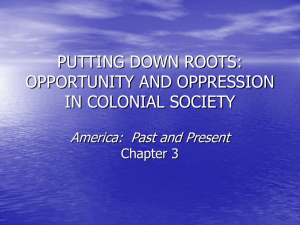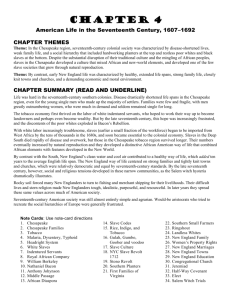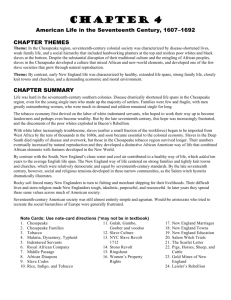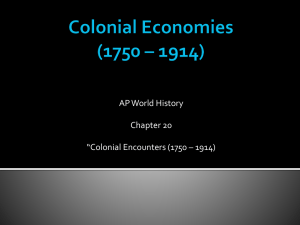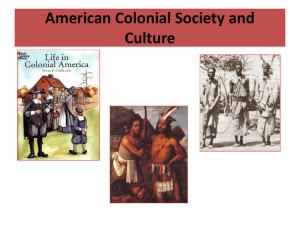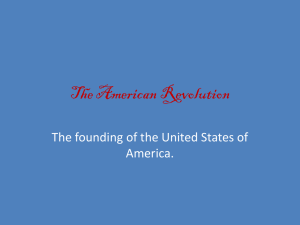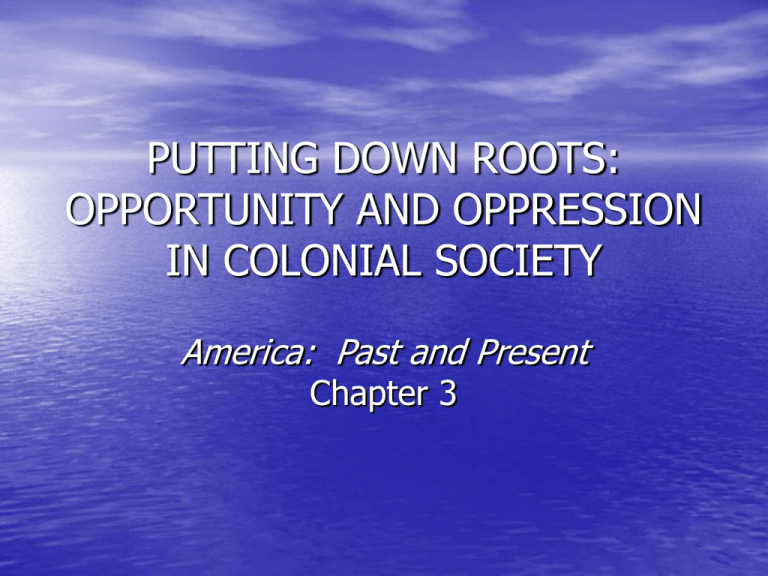
PUTTING DOWN ROOTS:
OPPORTUNITY AND OPPRESSION
IN COLONIAL SOCIETY
America: Past and Present
Chapter 3
Sources of Stability:
New England Colonies of the
Seventeenth Century
• New Englanders replicated traditional
English social order
• Contrasted with experience in other
English colonies
• Explanation lies in development of
Puritan families
Immigrant Families
and New Social Order
• Puritans believed God ordained the family
• Reproduce patriarchal English family
structure in New England
• Greater longevity in New England results
in “invention” of grandparents
• Multigenerational families strengthen
social stability
Commonwealth of Families
• Most New Englanders married neighbors
of whom parents approved
• New England towns collections of
interrelated households
• Church membership associated with
certain families
• Education provided by the family
Women’s Lives
in Puritan New England
• Women not legally equal with men
• Marriages based on mutual love
• Most Women contributed to society as
–
–
–
wives and mothers
church members
small-scale farmers
• Women accommodated themselves to
roles they believed God ordained
Social Hierarchy in New England
• Absence of very rich necessitates creation
of new social order
• New England social order becomes
–
–
–
local gentry of prominent, pious families
large population of independent yeomen
landowners loyal to local community
small population of landless laborers,
servants, poor
The Challenge of the Chesapeake
Environment
• Imbalanced sex ratio among immigrants
• High death rate
• Scattered population
Family Life at Risk
• Normal family life impossible in Virginia
–
–
–
mostly young male indentured servants
most immigrants soon died
in marriages, one spouse often died within a
decade
• Serial marriages, extended families
common
• Orphaned children raised by strangers
Women in Chesapeake Society
• Scarcity gives some women bargaining
power in marriage market
• Women without family protection
vulnerable to sexual exploitation
• Childbearing extremely dangerous
• Chesapeake women died 20 years earlier
than women in New England
The Structure of Planter Society:
The Gentry
• Tobacco the basis of Chesapeake wealth
• Great planters few but dominant
– arrive with capital to invest in workers
– amass huge tracts of land
– gentry see servants as possessions
• Early gentry become stable ruling elite by
1700
The Structure of Planter
Society: The Freemen
• The largest class in Chesapeake society
• Most freed at the end of indenture
• Live on the edge of poverty
The Structure of Planter Society:
Indentured Servants
• Servitude a temporary status
• Conditions harsh
• Servants regard their bondage as slavery
• Planters fear rebellion
The Structure of Planter Society:
Post-1680s Stability
• Gentry ranks open to people with capital
before 1680
• Demographic shift after 1680 creates
creole elite
• Ownership of slaves consolidates planter
wealth and position
• Freemen find advancement more difficult
The Structure of Planter Society:
A Dispersed Population
• Large-scale tobacco cultivation requires
–
–
great landholdings
ready access to water-borne commerce
• Result: population dispersed along great
tidal rivers
• Virginia a rural society devoid of towns
Race and Freedom
in British America
• Indians decimated by disease
• European indentured servant-pool wanes
after 1660
• Enslaved Africans fill demand for labor
Roots of Slavery
• First Africans to Virginia in 1619
• Status of Africans in Virginia unclear for 50 years
• Rising black population in Virginia after 1672
prompts stricter slave laws
– Africans defined as slaves for life
– slave status passed on to children
– white masters possess total control of slave life and
labor
– mixing of races not tolerated
Origins and Destinations of African
Slaves, 1619-1760
Constructing African American
Identities: Geography’s
Influence
• Slave experience differed from colony to
colony
• 60% of South Carolina population black
• Nearly half Virginia population black
• Blacks much less numerous in New
England and the Middle Colonies
Constructing African American
Identities: African Initiatives
• Older black population tended to look
down on recent arrivals from Africa
• All Africans participated in creating an
African American culture
–
Required an imaginative reshaping of African
and European customs.
• By 1720 African population, culture selfsustaining
Constructing African American
Identities: Slave Resistance
• Widespread resentment of debased status
• Armed resistance such as S. Carolina’s
Stono Rebellion of 1739 a threat
• Runaways common in colonial America
• Black mariners, other travelers link African
American communities
Rise of a Commercial Empire
• English leaders ignore colonies until 1650s
• Restored monarchy of Charles II
recognized value of colonial trade
• Navigation Acts passed to regulate,
protect, glean revenue from commerce
Response to Economic
Competition
• “Mercantilism” a misleading term for English
•
•
commercial regulation
Regulations emerge as ad hoc responses to
particular problems
Varieties of motivation
– crown wants money
– English merchants want to exclude Dutch
– Parliament wants stronger Navy—encourage domestic
shipbuilding industry
– everyone wants better balance of trade
Regulating Colonial Trade:
The Navigation Act of 1660
• Ships engage in English colonial trade
–
–
must be made in England (or America)
must carry a crew at least 75% English
• Enumerated goods only to English ports
–
–
1660 list included tobacco, sugar, cotton,
indigo, dyes, ginger
1704-05 molasses, rice, naval stores also
Regulating Colonial Trade:
The Navigation Act of 1663
• Goods shipped to English colonies must
pass through England
• Increased price paid by colonial
consumers
Regulating Colonial Trade:
Implementing the Acts
• Navigation Acts spark Anglo-Dutch trade
wars
• New England merchants skirt laws
• English revisions tighten loopholes
• 1696--Board of Trade created
• Navigation Acts eventually benefit colonial
merchants
Colonial Factions Spark Political
Revolt, 1676-1691
• English colonies experience unrest at the
end of the seventeenth century
• Unrest not social revolution but contest
between gentry “ins” and “outs”
• Winners gain legitimacy for their rule
Civil War in Virginia:
Bacon's Rebellion
• Nathaniel Bacon leads rebellion, 1676
• Rebellion allows small farmers, blacks
and women to join, demand reforms
• Governor William Berkeley regains
control
• Rebellion collapses after Bacon’s death
• Gentry recovers positions, unite over
next decades to oppose royal governors
The Glorious Revolution in the
Bay Colony: King Philip’s War
• 1675--Metacomet leads Wampanoag-
Narragansett alliance against colonists
• Colonists struggle to unite, defeat
Indians
• Deaths total 1,000+ Indians and
colonists
Glorious Revolution: The
Dominion of New England
• 1684--King James II establishes
“Dominion of New England”
–
–
–
colonial charters annulled
colonies from Maine to New Jersey united
Edmund Andros appointed governor
• 1689--news of James II’s overthrow
sparks rebellion in Massachusetts
The Glorious Revolution in the
Bay Colony: Outcomes
• Andros deposed
• William III and Mary II give Massachusetts
a new charter
–
–
incorporates Plymouth
transfers franchise from "saints" to those with
property
Contagion of Witchcraft
• Charges of witchcraft common
–
accused witches thought to have made a
compact with the devil
• Salem panic of 1691 much larger in scope
than previous accusations
• 20 victims dead before trials halted in late
summer of 1692
• Causes include factionalism, economics
The Glorious Revolution in New
York
• 1689--News of James II’s overthrow
prompts crisis of authority in New York
• Jacob Leisler seizes control
• Maintains position through 1690
• March 1691--Governor Henry Sloughter
arrests, executes Leisler
The Glorious Revolution in
Maryland
• 1689--news prompts John Coode to lead
revolt against Catholic governor
• Coode's rebellion approved by King
William
• Maryland taken from Calvert control
• 1715--proprietorship restored to the
Protestant fourth Lord Baltimore
COMMON EXPERIENCES,
SEPARATE CULTURES
Purpose
Families
Ethnicity
Economy
New
England
Religious
Nuclear
families
Mostly
English
Family
farms
Middle
Colonies
Mixed
Nuclear
families
Mixed
European
Family
farms
Chesapeake Gain
wealth
Extended
families
Lower South Gain
wealth
Extended
families
English
(majority)
& African
English &
African
(majority)
Market
plantations
(tobacco)
Market
plantations
(rice, indigo)
Local Aspirations Within an Atlantic
Empire
• By 1700 England’s attitude toward the
colonies had changed dramatically
• Sectional differences within the colonies
were profound
• They were all part of Great Britain but had
little to do with each other

